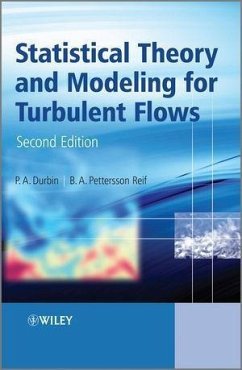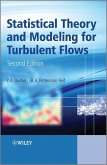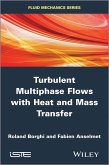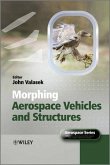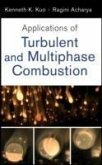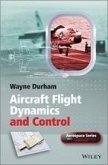Statistical Theory and Modeling for Turbulent Flows (eBook, ePUB)


Alle Infos zum eBook verschenken

Statistical Theory and Modeling for Turbulent Flows (eBook, ePUB)
- Format: ePub
- Merkliste
- Auf die Merkliste
- Bewerten Bewerten
- Teilen
- Produkt teilen
- Produkterinnerung
- Produkterinnerung

Hier können Sie sich einloggen

Bitte loggen Sie sich zunächst in Ihr Kundenkonto ein oder registrieren Sie sich bei bücher.de, um das eBook-Abo tolino select nutzen zu können.
Providing a comprehensive grounding in the subject of turbulence, Statistical Theory and Modeling for Turbulent Flows develops both the physical insight and the mathematical framework needed to understand turbulent flow. Its scope enables the reader to become a knowledgeable user of turbulence models; it develops analytical tools for developers of predictive tools. Thoroughly revised and updated, this second edition includes a new fourth section covering DNS (direct numerical simulation), LES (large eddy simulation), DES (detached eddy simulation) and numerical aspects of eddy resolving…mehr
- Geräte: eReader
- mit Kopierschutz
- eBook Hilfe
- Größe: 12.45MB
![Statistical Theory and Modeling for Turbulent Flows (eBook, PDF) Statistical Theory and Modeling for Turbulent Flows (eBook, PDF)]() P. A. DurbinStatistical Theory and Modeling for Turbulent Flows (eBook, PDF)89,99 €
P. A. DurbinStatistical Theory and Modeling for Turbulent Flows (eBook, PDF)89,99 €![Turbulent Multiphase Flows with Heat and Mass Transfer (eBook, ePUB) Turbulent Multiphase Flows with Heat and Mass Transfer (eBook, ePUB)]() Roland BorghiTurbulent Multiphase Flows with Heat and Mass Transfer (eBook, ePUB)164,99 €
Roland BorghiTurbulent Multiphase Flows with Heat and Mass Transfer (eBook, ePUB)164,99 €![Morphing Aerospace Vehicles and Structures (eBook, ePUB) Morphing Aerospace Vehicles and Structures (eBook, ePUB)]() Morphing Aerospace Vehicles and Structures (eBook, ePUB)125,99 €
Morphing Aerospace Vehicles and Structures (eBook, ePUB)125,99 €![Applications of Turbulent and Multi-Phase Combustion (eBook, ePUB) Applications of Turbulent and Multi-Phase Combustion (eBook, ePUB)]() Kenneth Kuan-Yun KuoApplications of Turbulent and Multi-Phase Combustion (eBook, ePUB)162,99 €
Kenneth Kuan-Yun KuoApplications of Turbulent and Multi-Phase Combustion (eBook, ePUB)162,99 €![Turbulent Drag Reduction by Surfactant Additives (eBook, ePUB) Turbulent Drag Reduction by Surfactant Additives (eBook, ePUB)]() Feng-Chen LiTurbulent Drag Reduction by Surfactant Additives (eBook, ePUB)156,99 €
Feng-Chen LiTurbulent Drag Reduction by Surfactant Additives (eBook, ePUB)156,99 €![Flows and Chemical Reactions in Heterogeneous Mixtures (eBook, ePUB) Flows and Chemical Reactions in Heterogeneous Mixtures (eBook, ePUB)]() Roger Prud'HommeFlows and Chemical Reactions in Heterogeneous Mixtures (eBook, ePUB)139,99 €
Roger Prud'HommeFlows and Chemical Reactions in Heterogeneous Mixtures (eBook, ePUB)139,99 €![Aircraft Flight Dynamics and Control (eBook, ePUB) Aircraft Flight Dynamics and Control (eBook, ePUB)]() Wayne DurhamAircraft Flight Dynamics and Control (eBook, ePUB)97,99 €
Wayne DurhamAircraft Flight Dynamics and Control (eBook, ePUB)97,99 €-
-
-
Dieser Download kann aus rechtlichen Gründen nur mit Rechnungsadresse in A, B, BG, CY, CZ, D, DK, EW, E, FIN, F, GR, HR, H, IRL, I, LT, L, LR, M, NL, PL, P, R, S, SLO, SK ausgeliefert werden.
- Produktdetails
- Verlag: John Wiley & Sons
- Seitenzahl: 372
- Erscheinungstermin: 28. Juni 2011
- Englisch
- ISBN-13: 9781119957522
- Artikelnr.: 37345269
- Verlag: John Wiley & Sons
- Seitenzahl: 372
- Erscheinungstermin: 28. Juni 2011
- Englisch
- ISBN-13: 9781119957522
- Artikelnr.: 37345269
- Herstellerkennzeichnung Die Herstellerinformationen sind derzeit nicht verfügbar.
model. 6.2.1 Analytical solutions to the k -
model. 6.2.2 Boundary conditions and near-wall modifications. 6.2.3 Weak solution at edges of free-shear flow; free-stream sensitivity. 6.3 The k -
model. 6.4 Stagnation-point anomaly. 6.5 The question of transition. 6.5.1 Reliance on the turbulence model. 6.5.2 Intermittency equation. 6.5.3 Laminar fluctuations. 6.6 Eddy viscosity transport models. Exercises. 7 Models with tensor variables. 7.1 Second-moment transport. 7.1.1 A simple illustration. 7.1.2 Closing the Reynolds stress transport equation. 7.1.3 Models for the slow part. 7.1.4 Models for the rapid part. 7.2 Analytic solutions to SMC models. 7.2.1 Homogeneous shear flow. 7.2.2 Curved shear flow. 7.2.3 Algebraic stress approximation and nonlinear eddy viscosity. 7.3 Non-homogeneity. 7.3.1 Turbulent transport. 7.3.2 Near-wall modeling. 7.3.3 No-slip condition. 7.3.4 Nonlocal wall effects. 7.4 Reynolds averaged computation. 7.4.1 Numerical issues. 7.4.2 Examples of Reynolds averaged computation. Exercises. 8 Advanced topics. 8.1 Further modeling principles. 8.1.1 Galilean invariance and frame rotation. 8.1.2 Realizability. 8.2 Second-moment closure and Langevin equations. 8.3 Moving equilibrium solutions of SMC. 8.3.1 Criterion for steady mean flow. 8.3.2 Solution in two-dimensional mean flow. 8.3.3 Bifurcations. 8.4 Passive scalar flux modeling. 8.4.1 Scalar diffusivity models. 8.4.2 Tensor diffusivity models. 8.4.3 Scalar flux transport. 8.4.4 Scalar variance. 8.5 Active scalar flux modeling: effects of buoyancy. 8.5.1 Second-moment transport models. 8.5.2 Stratified shear flow. Exercises. Part III THEORY OF HOMOGENEOUS TURBULENCE. 9 Mathematical representations. 9.1 Fourier transforms. 9.2 Three-dimensional energy spectrum of homogeneous turbulence. 9.2.1 Spectrum tensor and velocity covariances. 9.2.2 Modeling the energy spectrum. Exercises. 10 Navier-Stokes equations in spectral space. 10.1 Convolution integrals as triad interaction. 10.2 Evolution of spectra. 10.2.1 Small-k behavior and energy decay. 10.2.2 Energy cascade. 10.2.3 Final period of decay. Exercises. 11 Rapid distortion theory. 11.1 Irrotational mean flow. 11.1.1 Cauchy form of vorticity equation. 11.1.2 Distortion of a Fourier mode. 11.1.3 Calculation of covariances. 11.2 General homogeneous distortions. 11.2.1 Homogeneous shear. 11.2.2 Turbulence near a wall. Exercises. Part IV TURBULENCE SIMULATION. 12 Eddy-resolving simulation. 12.1 Direct numerical simulation. 12.1.1 Grid requirements. 12.1.2 Numerical dissipation. 12.1.3 Energy-conserving schemes. 12.2 Illustrations. 12.3 Pseudo-spectral method. Exercises. 13 Simulation of large eddies. 13.1 Large eddy simulation. 13.1.1 Filtering. 13.1.2 Subgrid models. 13.2 Detached eddy simulation. Exercises. References. Index.
model. 6.2.1 Analytical solutions to the k -
model. 6.2.2 Boundary conditions and near-wall modifications. 6.2.3 Weak solution at edges of free-shear flow; free-stream sensitivity. 6.3 The k -
model. 6.4 Stagnation-point anomaly. 6.5 The question of transition. 6.5.1 Reliance on the turbulence model. 6.5.2 Intermittency equation. 6.5.3 Laminar fluctuations. 6.6 Eddy viscosity transport models. Exercises. 7 Models with tensor variables. 7.1 Second-moment transport. 7.1.1 A simple illustration. 7.1.2 Closing the Reynolds stress transport equation. 7.1.3 Models for the slow part. 7.1.4 Models for the rapid part. 7.2 Analytic solutions to SMC models. 7.2.1 Homogeneous shear flow. 7.2.2 Curved shear flow. 7.2.3 Algebraic stress approximation and nonlinear eddy viscosity. 7.3 Non-homogeneity. 7.3.1 Turbulent transport. 7.3.2 Near-wall modeling. 7.3.3 No-slip condition. 7.3.4 Nonlocal wall effects. 7.4 Reynolds averaged computation. 7.4.1 Numerical issues. 7.4.2 Examples of Reynolds averaged computation. Exercises. 8 Advanced topics. 8.1 Further modeling principles. 8.1.1 Galilean invariance and frame rotation. 8.1.2 Realizability. 8.2 Second-moment closure and Langevin equations. 8.3 Moving equilibrium solutions of SMC. 8.3.1 Criterion for steady mean flow. 8.3.2 Solution in two-dimensional mean flow. 8.3.3 Bifurcations. 8.4 Passive scalar flux modeling. 8.4.1 Scalar diffusivity models. 8.4.2 Tensor diffusivity models. 8.4.3 Scalar flux transport. 8.4.4 Scalar variance. 8.5 Active scalar flux modeling: effects of buoyancy. 8.5.1 Second-moment transport models. 8.5.2 Stratified shear flow. Exercises. Part III THEORY OF HOMOGENEOUS TURBULENCE. 9 Mathematical representations. 9.1 Fourier transforms. 9.2 Three-dimensional energy spectrum of homogeneous turbulence. 9.2.1 Spectrum tensor and velocity covariances. 9.2.2 Modeling the energy spectrum. Exercises. 10 Navier-Stokes equations in spectral space. 10.1 Convolution integrals as triad interaction. 10.2 Evolution of spectra. 10.2.1 Small-k behavior and energy decay. 10.2.2 Energy cascade. 10.2.3 Final period of decay. Exercises. 11 Rapid distortion theory. 11.1 Irrotational mean flow. 11.1.1 Cauchy form of vorticity equation. 11.1.2 Distortion of a Fourier mode. 11.1.3 Calculation of covariances. 11.2 General homogeneous distortions. 11.2.1 Homogeneous shear. 11.2.2 Turbulence near a wall. Exercises. Part IV TURBULENCE SIMULATION. 12 Eddy-resolving simulation. 12.1 Direct numerical simulation. 12.1.1 Grid requirements. 12.1.2 Numerical dissipation. 12.1.3 Energy-conserving schemes. 12.2 Illustrations. 12.3 Pseudo-spectral method. Exercises. 13 Simulation of large eddies. 13.1 Large eddy simulation. 13.1.1 Filtering. 13.1.2 Subgrid models. 13.2 Detached eddy simulation. Exercises. References. Index.
